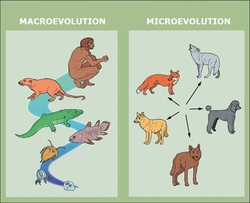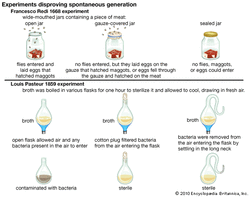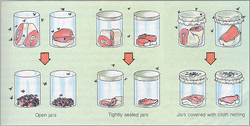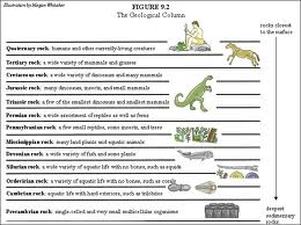
What is the definition for microevolution and macroevolution? Well according to Apologia: Exploring Creation with biology 2nd edition.p268
Microevolution-The theory that natural selection can over time, take organism and transform it into more specialized species of that organism.
Macroevolution-The hypothesis that processes similar to those at work in microevolution can over eons of time, transform an organism into a completely different kind of organism.
In simple explanation, the difference between microevolution and macroevolution is that macroevolution evolves from one simple life form into a more specific life form (ex. fish-human) and microevolution evolves from one type of life form and reproduces other life forms with certain different features (ex. wild dog-domesticated dog)
I believe that microevolution is true, but macroevolution doesn't exist and isn't possible for as it says in
Genesis 1;27
"So God created mankind in his own image, in the image of God he created them; male and female he created them."
One example that may be used to state that microevolution may have occurred after God's creation is through Adam and Eve. I believe that how we all got different appearances and colors is an example of microevolution. I have already stated on my first year portfolio before that God designed Adam and Eve, our first parents, to have a wide variety of genetics to reproduce different appearances to their descendants. it is also possible that Noah and his family inherited a wide variety of genetics too and reproduced different appearances of their descendants. As for the language and dialect, we all know that this happened in the Tower of Babel (Read Genesis 11;1-9)
Link to where I got the information and resource:
http://www.answersingenesis.org/get-answers/features/adam-eve-skin-tones-one-race
The macroevolution however, doesn't have any stable and definite evidence to support it. Many macroevolutionists say that the Geologic column is their evidence, but as we all know, science changes and isn't definite and stable so the people who are against macroevolution said that there is a possibility that these layers of strata was caused by natural disasters. One world-wide disaster that may support this possibility is the world-wide flood that occurred during Noah's time.
| You see you must understand that science has limitations. You must never put your trust in science because science cannot answer everything. As time moves, everything changes and grows old. We grow old, the animals and plants grow old, and so science changes too just as we change. But know that there is one Someone who is never changing, that is God. He is eternal, omnipotent, omnipresent, and omniscient in all aspects. |

Spontaneous generation-an idea that living forms were created from non-living things.
Abiogenesis- an idea that long ago, there were only simple life forms that spontaneously appeared.
Scientists didn't give up the idea of evolution. Darwin's work inspired scientists to prove another answer that life began without any creator. The idea of the spontaneous generation actually began long ago in 350 B.C. when Aristotle concluded that when men left meat open and allowed it to decay,maggots will appear. Aristotle made other observations to support his hypothesis on spontaneous generation. The spontaneous generation quickly became a theory because of the data that supported it.
In mid-1600's, a biologist whose name was Jean Baptist van Helmont, did an experiment that also supported the theory of spontaneous generation.

The result of Redi's experiment shocked the world because all experiments that were conducted for the spontaneous generation for the past 1,900 years seemed to support the theory!
Lazzaro Spallanzani, a contemporary of Needham argued that it is either that Needham didn't boiled the infusion for too long or the cork allowed microorganisms to enter. Thus he revised Needham's experiment but he melted the opening of the flask to allow any microorganisms to enter. This seal was airtight so then again the other scientists complained that without air, nothing can live.
The argument on spontaneous generation went on until one day, Louis Pasteur conducted an experiment that refuted the theory of spontaneous generation. He showed ,using his swan-necked flasks, that microorganisms enter through the opened flask but are prevented from mixing with the infusion due to the curved-bent of the flask.
3. Big Bang- the last topic that I won't be discussing is this big bang evolution.
"Big bang, at first there was nothing then BOOM! the universe was created."
-Dr. Chuck Missler
The thing that I don't get is why do scientists believe in the big bang evolution if they don't even know how it BANG! in the first place? What is it that BOOMED! ? Where did the heat ,that big bang evolutionists state was the reason that the universe slowly unfolded, come from?
Well now that these evolution theories are explained, what now?
NOTE: All pictures used are from Google.



 RSS Feed
RSS Feed